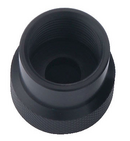View attachment 508033 Hey Doc...
As has already been stated...I too have been soaking/hose flushing 2nd stage regulators for years with no water intrusion problems...the key is not to press the purge button on the 2nd stage if it's not pressurized...the knife edge will seal out water against the LP seat...no problem...
For all DIN 1st stage applications...push/pull ''dust caps'' should be replaced with threaded DIN caps...with the hanger strings threaded through a diagonal drilled hole in the end of the cap...if the caps are of the type that are not drilled through...they will provide a water tight seal against the captured ''O'' ring on the male DIN fitting...soak and hose flush to your hearts content...
Delrin versions are the best...Delrin is very stable...not affected by heat/cold expansion/contraction...
Four dollars at DGX...plastic versions are $2.
Dive shop dunk/rinse tanks are only clean in the morning...if then...when salt water diving the most important thing when rinsing...regardless of what it is...to clean while everything is still wet...if you wait until everything has dried...and salt crystals have formed...you've waited too long...and you've just started a love/hate relationship...your gear will hate you...the dive shop service departments will love you...
Best...
Warren



